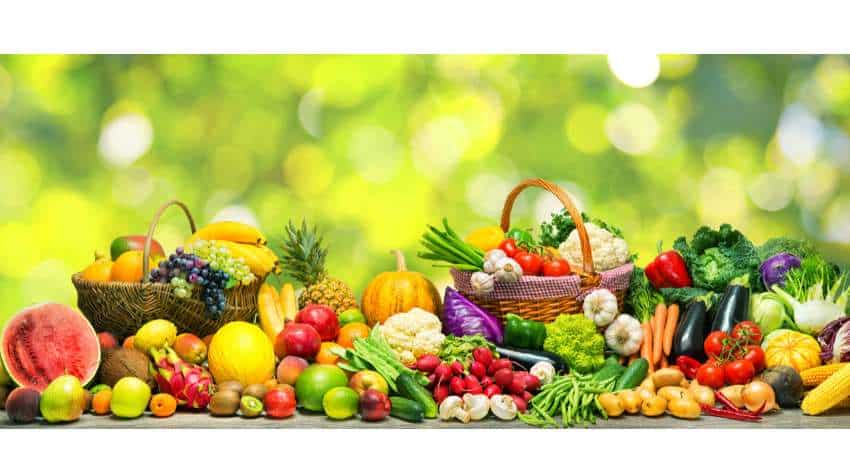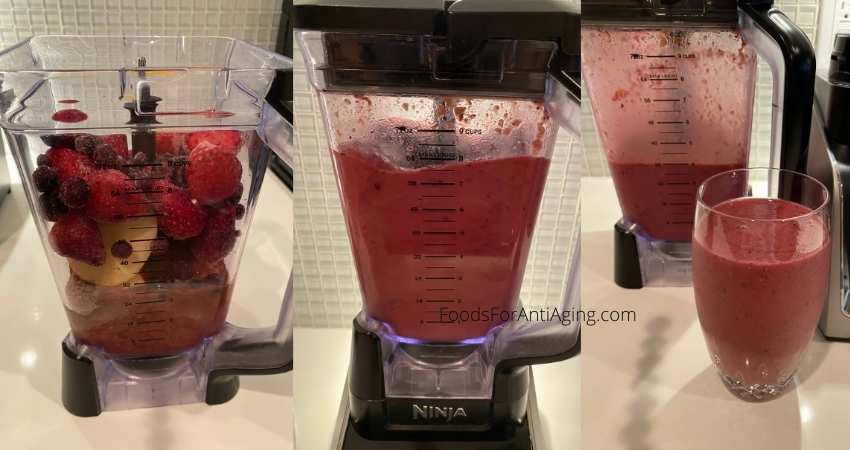Is It Okay To Substitute Fruit For Vegetables?
Despite their nutritional similarities, fruits and vegetables are not nutritionally equal. Both have significant differences, and they’re used for different purposes. But is it okay to substitute fruit for vegetables?
It’s not permissible to substitute fruit for vegetables entirely. The Dietary Guidelines for Americans recommend consuming 2 1/2 cups of vegetables and 2 cups of fruit per day. It is possible to substitute fruit for certain vegetables in a meal as long as the recommended daily servings of both are met for the day.
This article will discuss the Dietary Guidelines for Americans in more detail. In addition, I’ll examine the nutritional differences between the two and the possible substitutions you could make.
As a Certified Health Coach many clients ask about this topic often. For this reason and my personal use, I’ve researched replacing vegetables prior to, during and after writing this article.

The Daily Recommendation for Fruits and Vegetables
The Dietary Guidelines for Americans
The Dietary Guidelines for Americans is published by the United States Department of Agriculture (USDA) and the U.S. Department of Health and Human Services.
The aim of the Dietary Guidelines is to promote health and prevent disease.
The core elements making up a healthy dietary pattern include the following:
- Vegetables of all types
- Fruits, especially whole
- Grains
- Dairy
- Protein foods
- Oils
For the purpose of this article, we’ll be concentrating on fruits and vegetables. The daily recommendation for them both are the following:
- Vegetables – 2 1/2 cups per day
- Fruits – 2 cups per day
The above cups may vary according to your age. Most adult women range from 2-3 cups and men 2 1/2 to 4 cups.
Eliminating either one entirely from your diet would be an unhealthy choice. Fruits cannot replace vegetables under most circumstances.
Consuming the recommended balance between the two will provide the different nutrients offered from each type of food.
Eliminating one particular vegetable due to a fussy eater is okay as long as the replacement is substituted with an equivalent option.
Nutrition: Some Nutrients Are Only Found in Fruits or Vegetables
Vegetables provide phytochemicals called glucosinolates fruits don’t contain. Phytochemicals or phytonutrients are chemicals plants produce to protect themselves from pests and diseases.
Vegetables come from the plant’s leaves, stems and roots, the parts most susceptible to pests and diseases.
The fact that they come from the parts of plants most exposed to attack by disease and plants may explain why they contain phytochemicals that fruits don’t.
However, what might be surprising is the phytochemicals continue their protective function in the human body after the food containing them are consumed.
On the other hand, fruits are better sources of certain nutrients. For example, they offer more fiber than leafy greens. Still, while the sweeter taste presents a reason for serving them to children who won’t eat vegetables, it also offers caution. Fruits have higher levels of natural sugars.
If you’re looking for a way to encourage children and others to eat vegetables, consider picking up the some cookbooks. Many of them contain kitchen-tested recipes from many cuisines and include information with tips and techniques for preparing and cooking them.
Vegetables Are Superior Sources of These Nutrients
Certain nutrients found in vegetables are better than those found in fruits. That’s why while you can substitute fruit for vegetables in your dishes, it’s always best to include them both whenever possible.
You can benefit from the nutrients both foods can offer.
Calcium
Like milk and other dairy products, vegetables represent a source of calcium. Calcium helps maintain strong bones throughout your life. Because your nervous system requires calcium to function properly, this nutrient also affects your muscles, including your heart muscle.
Although results aren’t fully conclusive, calcium may also reduce high blood pressure and protect you from diabetes and cancer.
B Vitamins and Folates
In addition, vegetables also provide a major source of B vitamins. B vitamins include:
- B1 (thiamin)
- B2 (riboflavin)
- B3 (niacin)
- B5
- B6
- B7 (biotin)
- B9 (folate)
- B12
B vitamins help support the following:
- Maintain the health of the cells.
- Assist in creating new blood cells.
- Help convert food into energy.
- Help protect against disease.
- Help reduce the body’s physiological reactions to stress.

Carotenoids
Leafy green and orange, yellow, olive-green and red vegetables are good sources of carotenoids like the following:
- Alpha-carotene
- Beta-carotene
- Lutein
- Lycopene
- Zeaxanthin
These nutrients act as antioxidants, protect your eyes from macular degeneration, slow the aging of the brain, and improve the function of the immune system.
The Linus Pauling Institute at Oregon State University hosts the Micronutrient Information Center on their website. Tables 2 through 6 from the report on carotenoids1 demonstrate that, while fruits do provide some carotenoids, the following vegetables are superior sources:
- Carrots
- Yams
- Sweet potatoes
- Bell peppers
- Spinach
- Kale
- Broccoli
Glucosinolates
Fruits do offer some types of anti-inflammatory phytochemicals. However, cruciferous vegetables, ones from the Brassica family, provide the only source of phytochemicals known as glucosinolates.
Glucosinolates are believed to provide protection from cancer. The Brassica family includes:
- Mustard
- Cabbage
- Cauliflower
- Broccoli
- Brussels sprouts
- Bok choy
- Kohlrabi
- Watercress,
- Turnips
- Kale
- Collard greens

Smoothie Tip: Add frozen fruit instead of ice. This increases the nutrient density and taste of the smoothie. If you’re interested in a Vitamix blender, check out my review, Vitamix Venturist V1220 Review.
Fruits Contain More of These Nutrients
There are nutrients available in both foods. However, the nutrients below are more available in fruits.
Vitamin C
Citrus fruits represent a particularly good source. Vitamin C helps protect against:
- Cardiovascular disease
- Eye disease
- Immune system deficiencies
- Prenatal health problems
- Aids in the body’s absorption of iron
Additional sources of vitamin C include:
- Tomatoes
- Strawberries
- Kiwi
- Potatoes
- Green peas
- Spinach
- Red and green peppers
Anthocyanins
Berries contain anthocyanins. Anthocyanins are among a group of compounds known as polyphenols. Polyphenols may protect against heart disease and blood clots, improve brain function, mental health and aid digestion.
Sources include:
- Grapes
- Apples
- Plums
- Red berries
- Purple berries

On days I know I won’t be able to consume or cook the proper amount of veggies or fruit, I’ll often include them in a smoothie and take it on the road.
Dietary Fiber
Naturally, both foods contain dietary fiber, but fruits offer more.
Leafy vegetables may consist of 84 to 95 percent water and provide only 1.2 to 4 grams (0.04 to 0.14 oz) of fiber per 100 grams (3.52 oz).
On the other hand, fruits may consist of 61 to 89 percent water and provide 2 to 15 grams (0.07 to 0.52 oz) of fiber per 100 grams (3.52 oz).
What Counts as One Cup
We already know the recommendation is to consume 2 1/2 cups of vegetables per day and 2 cups of fruit for most adults. Instead of chopping up a vegetable or fruit, you may want to eat it whole, like a carrot, apple or a celery stalk.
This makes it impossible to measure what you’re eating into a cup. The following graph provides the equivalent of common vegetables equaling one cup.
| Vegetable | The amount counting as
1 cup of vegetables. |
| Carrots | 2 medium carrots |
| Raw leafy greens | 2 cups of fresh greens |
| Sweet potato | 1 large sweet potato baked |
| White potato | 1 medium white potato
boiled or baked |
| Corn | 1 large ear of corn |
| Tomatoes | 1 large tomato
2 small tomatoes |
| Bell peppers | 1 large bell pepper |
| Celery | 2 large stalks |
| Pimento | 3 whole |
The following graph provides the equivalent of common fruits equaling one cup.
| Fruit | The amount counting as
1 cup of fruit. |
| Apple | 1 small apple
1/2 large apple |
| Banana | 1 large banana |
| Grapes | 22 seedless grapes |
| Grapefruit | 1 medium grapefruit |
| Guava | 3 guavas |
| Kiwi | 2 to 3 kiwis |
| Orange | 1 large orange |
| Peach | 1 large peach |
| Strawberries | 8 large strawberries |
| Watermelon | 1 small wedge or slice |
| Plum | 3 medium plums
2 large plums |
| Pear | 1 medium pear |
Fruits Have More Sugar
One important disadvantage of substituting fruit for all vegetables is fruits contain higher levels of natural sugars than vegetables. Dried fruits concentrate sugar levels, and fruit juices, some are really bad, eliminate the fiber slowing the absorption of sugar.
When serving them, it’s best to serve whole fresh or frozen. In addition, it’s great to offer them as substitutes for desserts and other sweet treats like candy bars, cookies, doughnuts, cupcakes, cakes, etc.
Find out 15 healthy mashed potato substitutes in my article, Mashed Potato Substitutes: 15 Healthy Alternatives.
6 Tips for Giving Kids the Right Vegetables
If you’re a fussy eater or have one in your household, it’s probably going to take some time to find vegetables the fussy eater will eat. You probably hear the word no often.
In addition, it may be difficult to find a way to prepare them differently the fussy eater will like. If you would like to turn the no into a yes, continue reading.
6 Health Tips for Fussy Eaters:
1. Try encouraging sweeter-tasting varieties like sweet potatoes or beets.
2. You can also glaze acorn or butternut squash with honey or sweeten frozen winter squash with honey or natural maple syrup. Technically, botanists classify squashes as fruits because the flower of the squash vine produces them.
3. Chefs, however, classify squashes as vegetables because of their taste.
4. Mix fruits with vegetables as you attempt to get the fussy eater to accept greens. Choose fruits containing the highest nutrients normally provided by greens like B vitamins and carotenoids.
5. Add vegetables to dishes the fussy eater already likes. Adding them to macaroni and cheese or topping pizza with some is a great idea.
6. Try stir-fried or carrot and celery sticks with a dipping sauce.
7. Use natural, healthy juice, without added sugar, to help replace certain citrus fruits or veggies.
Ensure You Always Have the Right Fruits and Vegetables at Home to Eat
You may also face times when someone who usually eats vegetables doesn’t feel like eating them and may not feel like eating anything at all. Instances of diminished appetite can be due to illness or medication.
In such a case, nutrition is important, but taking in calories may be more important. In that situation, if you or the other adult will eat fruits instead, by all means, eat fruit.
Make sure you always have the right types at home. That way, you’ll always have the varieties your family member is willing to eat.
Find out what fruits and vegetables they like so you can always have those ready in your kitchen.
Grapes and Oranges Are Good Substitutes
As mentioned earlier, there may be times when substituting fruit for a vegetable is necessary. Whether it’s for a child, you or an adult, you’ll want to substitute fruits coming close to the same nutritional values as the greens.
Below are some suggestions for those times when it may be necessary to substitute one for the other:
- Grapes offer a source of antioxidants similar to onions.
- Oranges, kiwi and green peppers provide nearly equal amounts of vitamin C.
- Dried apricots and avocados provide more fiber than green peas.
- Sweet potatoes, squash and carrots provide vitamin A and folic acid.
- Fruits offer vitamin C and also provide folic acid.
- Those who dislike plain greens may enjoy pasta and veggie dishes. Try adding them in, finely chopped, to pasta sauces or Asian stir-fries with or without meat.
- If your children or others reject cooked veggies, try offering them salads or raw vegetable sticks.
Many low carb substitutes for sweet potatoes are different due to flavor. Check those out in my article, Keto Substitute for Sweet Potatoes: 8 Healthy Substitutes.
For more information on the nutrients contained in specific fruits and vegetables, search FoodData Central2, a database hosted by the U.S. Department of Agriculture.
Additional Article Resources34567 ((USDA MyPlate: Vegetables))8
If you have any questions about this article don’t hesitate to email us. You can find an email on our contact page.
Read Next – More Food Articles
10 Best Alternatives for Avocado in Sushi
5 Best Alternatives for Pomegranate in Salad
5 Best Alternatives for Spinach When Cooking
Alternatives To Sweet Potatoes: 16 Unbeatable Substitutes
8 Healthy Sweet Potato Flour Substitutes
- Oregon State University: Carotenoids [↩]
- USDA: FoodData Central [↩]
- U.S. Department of Health and Human Services: Current Dietary Guidelines [↩]
- U.S. Department of Health and Human Services: About the Dietary Guidelines [↩]
- Food and Agriculture Organization of the United Nations: Food-based dietary guidelines – Unites States of America [↩]
- Harvard Health Publishing: A look at the 2020-2025 Dietary Guidelines for Americans [↩]
- USDA: Dietary Guidelines [↩]
- USDA MyPlate: Fruits [↩]
